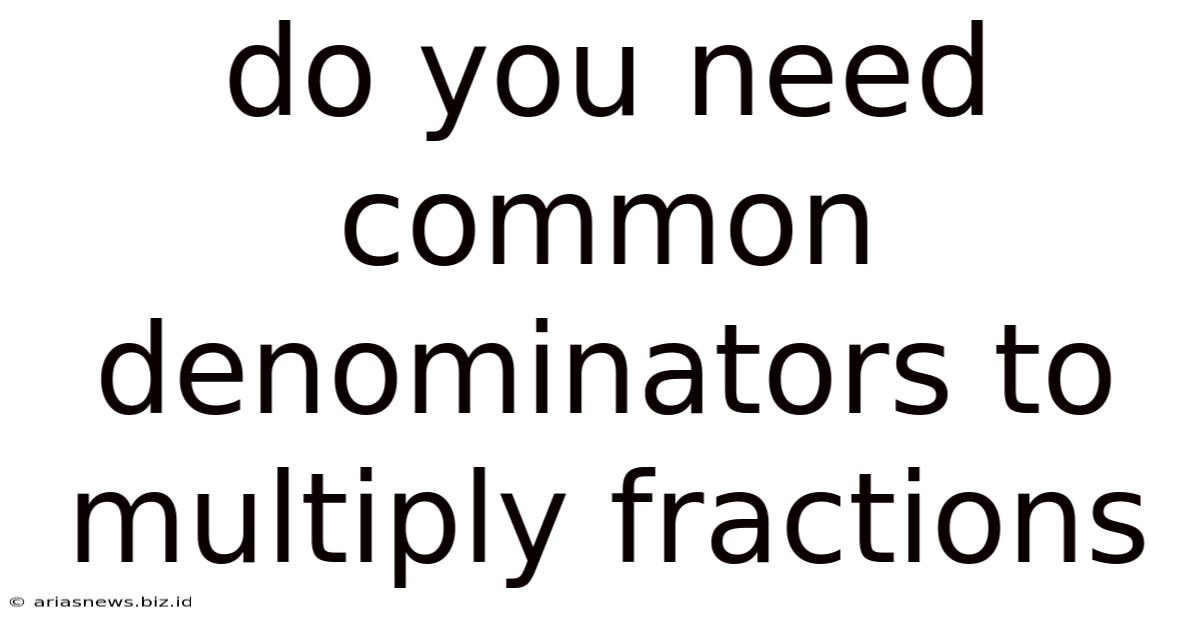Do You Need Common Denominators To Multiply Fractions
Arias News
May 09, 2025 · 4 min read

Table of Contents
Do You Need Common Denominators to Multiply Fractions?
The short answer is: no. Unlike adding and subtracting fractions, multiplying fractions does not require finding a common denominator. This fundamental difference often trips up students transitioning from addition and subtraction to multiplication and division of fractions. Let's delve deeper into why this is the case, exploring the underlying mathematical principles and providing clear examples.
Understanding Fraction Multiplication
The core concept behind multiplying fractions lies in understanding what a fraction represents: a part of a whole. When you multiply two fractions, you're essentially finding a fraction of a fraction. For example, 1/2 * 1/3 means finding one-third of one-half.
Visually, imagine a rectangle divided into halves (horizontally). Now, divide each of those halves into thirds (vertically). You'll have a rectangle divided into six equal parts. The product of 1/2 and 1/3 represents one of these six parts, which is 1/6.
Mathematically, the process is straightforward:
- Multiply the numerators (top numbers): This gives you the numerator of the resulting fraction.
- Multiply the denominators (bottom numbers): This gives you the denominator of the resulting fraction.
Therefore, 1/2 * 1/3 = (1 * 1) / (2 * 3) = 1/6. Notice that we didn't need to find a common denominator at any point.
Why Common Denominators Aren't Necessary
The need for common denominators in addition and subtraction stems from the necessity of combining or comparing parts of the same whole. To add 1/2 and 1/3, we need to express both fractions in terms of the same size pieces. This is why we find a common denominator (in this case, 6) and rewrite the fractions as 3/6 and 2/6, respectively. Then, we can add the numerators: 3/6 + 2/6 = 5/6.
Multiplication, however, doesn't involve combining parts of the same whole in the same way. We're finding a fraction of another fraction, not directly combining them. The process of multiplying numerators and denominators directly accounts for this "fraction of a fraction" concept.
Examples of Multiplying Fractions Without Common Denominators
Let's look at a few more examples to reinforce the idea:
Example 1:
2/5 * 3/7 = (2 * 3) / (5 * 7) = 6/35
Here, we simply multiply the numerators (2 * 3 = 6) and the denominators (5 * 7 = 35). There's no need for a common denominator.
Example 2:
4/9 * 5/6 = (4 * 5) / (9 * 6) = 20/54
Again, we multiply numerators and denominators directly. Notice that the resulting fraction, 20/54, can be simplified by dividing both the numerator and denominator by their greatest common divisor (GCD), which is 2. This simplifies to 10/27. Simplification is a separate step after multiplication; it's not related to the need for a common denominator before multiplying.
Example 3:
1 ½ * 2/3 (Mixed Numbers)
First, we convert the mixed number 1 ½ to an improper fraction: 3/2. Then, we multiply:
3/2 * 2/3 = (3 * 2) / (2 * 3) = 6/6 = 1
This example demonstrates that even with mixed numbers, the principle remains the same. Convert to improper fractions, multiply numerators and denominators, and simplify if necessary.
Common Mistakes to Avoid
While the process of multiplying fractions is relatively straightforward, some common mistakes can occur:
-
Forgetting to multiply both numerator and denominator: Remember to multiply both the numerators and the denominators. Multiplying only the numerators or only the denominators will result in an incorrect answer.
-
Not simplifying the resulting fraction: After multiplying, always check if the resulting fraction can be simplified by finding the greatest common divisor (GCD) of the numerator and the denominator and dividing both by it.
Simplifying Before or After Multiplication?
While you don't need to simplify before multiplying, it can sometimes make the calculation easier. Consider this example:
15/20 * 4/5
We can simplify 15/20 to 3/4 before multiplying:
3/4 * 4/5 = (3 * 4) / (4 * 5) = 12/20 = 3/5
Alternatively, multiplying directly would give us:
15/20 * 4/5 = 60/100 = 3/5
Both methods yield the same result. Simplifying beforehand can reduce the size of the numbers you're working with, potentially making the calculation simpler. However, it's not a requirement.
Multiplying Fractions with Whole Numbers
Multiplying a fraction by a whole number is also straightforward. Simply express the whole number as a fraction with a denominator of 1.
Example:
3 * 2/5 = 3/1 * 2/5 = (3 * 2) / (1 * 5) = 6/5
Conclusion: Multiplication's Unique Simplicity
In contrast to the complexities of adding and subtracting fractions which necessitates finding common denominators, multiplying fractions offers a more streamlined process. The straightforward multiplication of numerators and denominators reflects the inherent mathematical operation of finding a fraction of a fraction. Understanding this fundamental difference is crucial for mastering fraction operations and building a strong foundation in mathematics. Remember to always simplify the resulting fraction to its lowest terms for a complete and accurate answer. By avoiding common pitfalls and embracing the simplicity of the process, you can confidently tackle any fraction multiplication problem.
Latest Posts
Latest Posts
-
Is A Pint Bigger Than A Fifth
May 11, 2025
-
How Many Kilometers Are In 6 5 Miles
May 11, 2025
-
How Many Barrels Of Oil In A Tonne
May 11, 2025
-
How Far Is Texas A And M From Austin
May 11, 2025
-
How Many Cups Does 8 Oz Of Cheese Make
May 11, 2025
Related Post
Thank you for visiting our website which covers about Do You Need Common Denominators To Multiply Fractions . We hope the information provided has been useful to you. Feel free to contact us if you have any questions or need further assistance. See you next time and don't miss to bookmark.